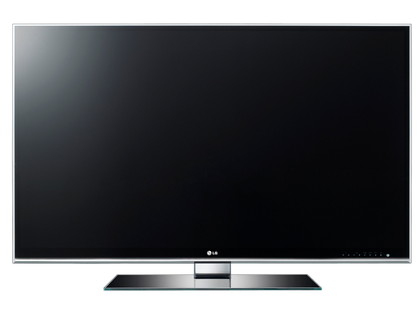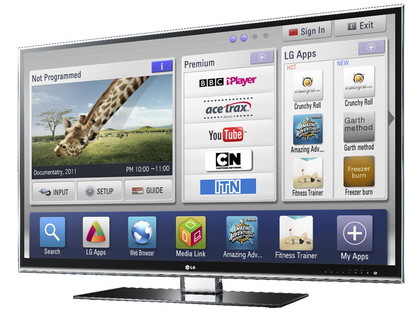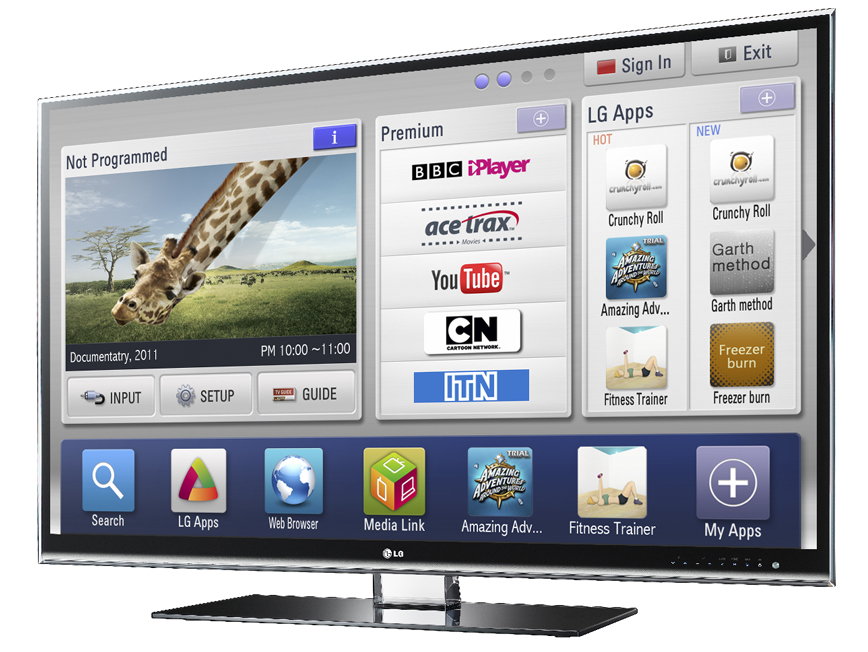Why you can trust TechRadar

Using direct LED lighting in the 55LW980T is a bold statement of intent for LG, showing just how far the brand is prepared to go to chase the enthusiast market. After all, such lighting is much more expensive to produce than edge LED lighting - especially when you use 288 separately controllable LED clusters like the LG 55LW980T does.
It's certainly worth noting that LG's greatest rival, Samsung, no longer seems interested in trying to offer a direct LED option in its TVs.
Direct LED traditionally requires a markedly deeper rear end than edge LED technology. But LG seems to have moved past this problem pretty emphatically with the 55LW980T. Its rear end sticks out by only 27mm, making it actually slimmer than most edge LED TVs. LG has accomplished this feat by introducing an "advanced light emitting filter" in front of the LED lights, which dissipates the light to deliver a brighter, smoother, more evenly lit final image.
There is a concern, perhaps, over whether the filter might potentially reduce black levels while it goes about its light-diffusing work, but at this point at least it's only fair to give LG's technology the benefit of the doubt.
Especially as that technology has helped to produce such a gorgeous-looking TV. Because as well as striking slimness, the LG 55LW980T enjoys a pleasingly narrow bezel - just 1.7cm across - and a single-layer fascia, with the top sheet of glass that covers the whole face extending slightly beyond the black bezel on each side in a cunning bid to emphasise the TV's slender profile.
As noted earlier, all 288 light clusters behind the LG 55LW980T's screen are individually controllable, thanks to a process known as local dimming. This key feature enables much greater control over the light levels of specific areas of the screen than you can get with edge LED lighting, with obvious potential benefits for contrast (LG quotes a contrast ratio of 10,000,000:1). The LG 55LW980T even goes so far as to provide three different strengths of its local dimming process.
The LG 55LW980T was originally going to get an active 3D system, but a few months ago LG decided that this potentially sent out mixed messages regarding the brand's preferred passive 3D alternative. So the LG 55LW980T arrives with one of LG's polarising filters applied to the front of its screen, and seven pairs of free glasses.
Sign up for breaking news, reviews, opinion, top tech deals, and more.
Clearly this number of free 3D glasses is designed to rub the active 3D camps' noses in the fact that LG passive glasses cost peanuts to make while pairs of active 3D glasses cost anywhere between £60 and £120 a pair.
The LG 55LW980T also carries 2D to 3D conversion, and allows you to adjust the 3D image's depth and viewpoint settings. These are both welcome tools, given how some people have different tolerances to different levels of 3D effect.
LG has left seemingly no stone unturned in its bid to produce a picture that's both impressive and flexible enough to suit any tastes and needs - including those of calibration outfit the Imaging Science Foundation (ISF), which has given the LG 55LW980T its full backing. There's a reasonably extensive colour management system, for instance, as well as white balance fine-tuning and extensive gamma adjustments.
There's also an almost infinite amount of control over just about every element of the LG 55LW980T's video processing, from its dynamic contrast engine through to its colour boosters, noise reduction systems and motion compensation tools.

Particularly welcome is the facility to adjust the individual levels of processing power applied by the set's TruMotion system to the separate judder and blur motion issues you invariably get with LCD screens.
Another big potential draw of the LG 55LW980T is its multimedia functionality - especially its Smart TV online services. LG has made giant strides in this department since 2010, first by massively ramping up its content level, then by introducing a great-looking interface.
It's interesting to note, too, that LG has recently added a significant number of extra online video-based features over the past month or so, including the Blinkbox TV and movie library, Autocar, a 3D Zone of streamable 3D content and an ITN news feed.
These join a roster that includes YouTube, BBC iPlayer, AceTrax, the HIT Entertainment channel, Box Office 365, the Cartoon Network, iConcerts and Daily Motion.
As well as the now really impressive store of video streaming sources, LG's Smart TV service carries an abundance of lesser apps. These still continue to be mostly forgettable, apart from the inevitable Facebook/Twitter social networking apps. But there are a few gems among them now, including a Crunchy Roll app that provides access to a startling selection of Manga and Anime sources.
It was a little disappointing to find the LG 55LW980T's Smart TV system working seemingly as sluggishly as that of LG's 50PZ950T plasma TV. Particularly aggravating is the way some features insist on taking an age to load unnecessary header graphics before letting you access their features.
The LG 55LW980T did score a major Smart TV success over the 50PZ950T, though, courtesy of the fact that its online services all seem to actually work. There was no repeat of the stuttering while streaming video and crashing apps found with the 50PZ950T. Phew.
The LG 55LW980T also supports streaming of a wide selection of file types - including HD Video - from DLNA PCs, and you can get all these goodies via either a LAN port or a built-in Wi-Fi system.
The LG 55LW980T additionally supports playback of a similar selection of multimedia files from USB drives, and can also record from the built-in Freeview HD tuner to correctly formatted USB storage drives.
One last rather cool feature of the LG 55LW980T, if you're a gamer, is its Dual Play mode. This uses the polarising properties of the screen to enable two players to enjoy full-screen gaming simultaneously. You just need to purchase two pairs of special glasses that only show one 'half' of the screen's polarised signal to each player.
While there's obviously considerable resolution loss if you take this gaming approach, it's still vastly preferable to trying to play a two-player game using the usual split-screen system.
Wrapping up this section of the review with a quick connections count, the highlights are four HDMIs, two USBs, a D-Sub PC port, the aforementioned Wi-Fi and LAN ports, and an RS-232C port for system integration.

John has been writing about home entertainment technology for more than two decades - an especially impressive feat considering he still claims to only be 35 years old (yeah, right). In that time he’s reviewed hundreds if not thousands of TVs, projectors and speakers, and spent frankly far too long sitting by himself in a dark room.
